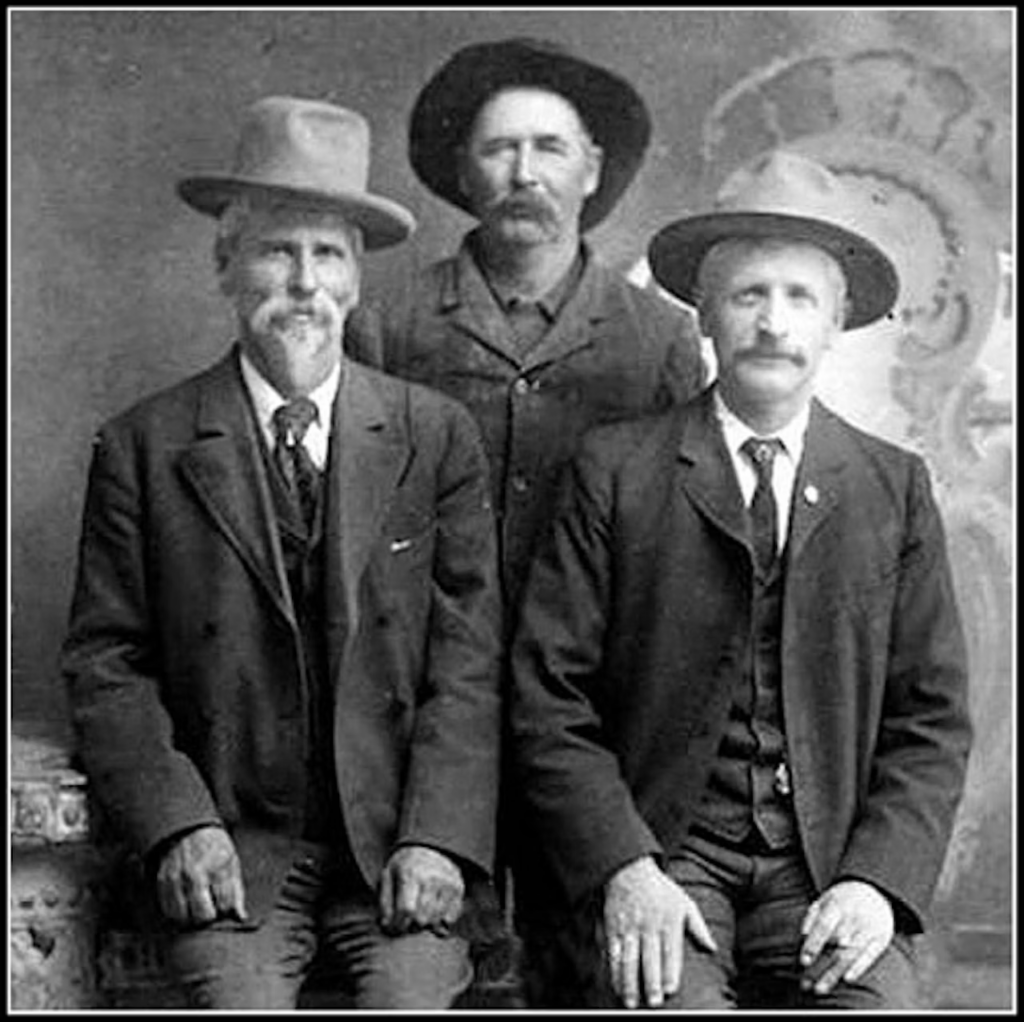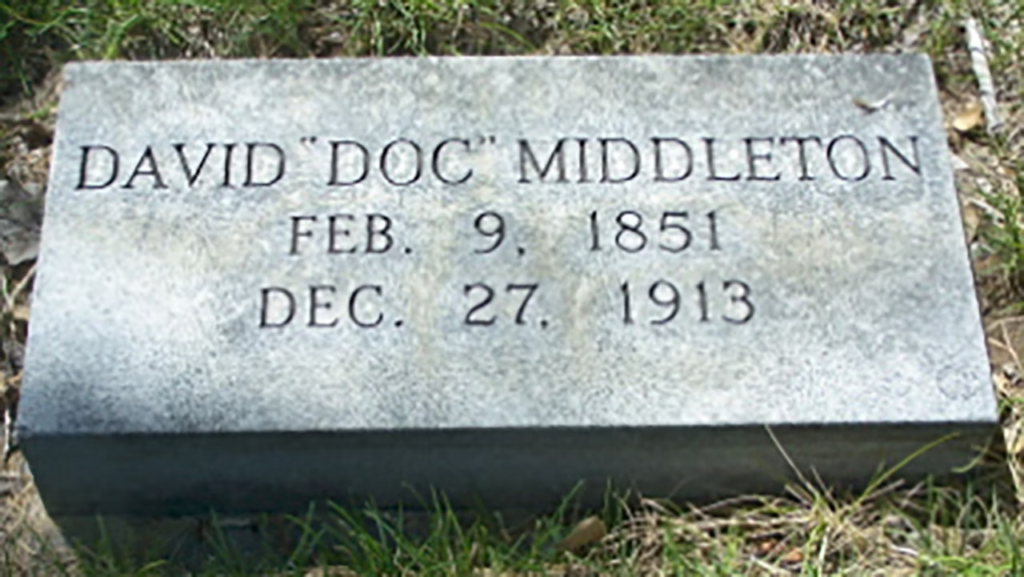A pretty interesting read on an outlaw who reformed. Consequently, movies and media portray justice during this time as being severe with people being hung for stealing horses, but having visited the territorial prison museum in Laramie, even people that committed murder only served a few years. And as you read these historical accounts, you see that they had ample opportunity to change their ways.
Park Cemetery in Douglas contains the remains of Doc Middleton, a true notorious Western outlaw. Although he stole horses, rustled cattle and killed men, he became an outlaw celebrity.
By Dale Killingbeck

He was an outlaw of many names but had one that made him famous — Doc Middleton.
That name was on the front page of The New York Times in 1879. It’s also on a headstone in Park Cemetery in Douglas, Wyoming, where he came to his final resting place.
He was possibly born as James Middleton Riley in 1851 in Bastrop, Texas, and was alleged to have used the name David Charles Middleton and David Cherry Middleton. He also was known as Henry Shepherd and by the alias Riley, according to the Nebraska State Historical Society, but nobody knows for sure his real name.
What is known about the notorious horse and cattle thief is that he became a legend in his own time.
When Middleton participated in a 1,000-mile horse race promoted by Buffalo Bill Cody in 1893, many thought he would win. And during Cheyenne Frontier Days in the 1890s, his name generated a crowd. He even contemplated forming a Western touring company patterned after Buffalo Bill’s “Wild West Show.”
“Doc” Middleton first appeared in newspapers nationwide in the late 1870s. The Doc nickname could have come from an incident tending to a wounded friend, his skill at healing horses or his ability to change brands on livestock. All are various explanations found in news accounts.
“The name of Doc Middleton, the notorious outlaw is become somewhat familiar throughout Nebraska and the west, owing to his frequent bold exploits as a horse and cattle thief,” the Cheyenne Democratic Leader reported April 8, 1879. “No definite account of this man and his various villainies has ever been published. The narrative of events of his criminal career would fill a large volume.”
Middleton is thought to have worked as a cowboy in Texas. Some accounts have him being charged with a killing there. That could not be confirmed.
Fight And Flight
What is known is that in 1877 he was in Sidney, Nebraska, and got into a fight with soldier who was bigger and stronger than he was.
Middleton drew his revolver and shot him. Then he escaped into the northern Nebraska territory where he gathered a gang called the Pony Boys and made stealing horses and cattle his career.
In the fall of that year, he stole 35 horses from a rancher north of Cheyenne and was pursued and captured by a livestock detective named William C. Lykins. Middleton was housed in a little log jail in Sidney.
“He escaped during the night by tearing up the floor and tunneling his way out by means of an old fire shovel, which it was claimed by the jailer had been accidentally within his reach,” the Democratic Leader reported.
The newspaper said he and his gang then established ranches in secluded rendezvous spots in Niobrara Country and ramped up their rustling efforts. Estimates state the gang that targeted Native Americans and ranchers stole and sold 3,000 horses between 1877 and 1879 in Nebraska, Dakotas, Iowa, Wyoming and Colorado.
In his outlaw prime he was described as 6 feet tall with sharp, gray eyes, auburn hair, beard and mustache with a slim build. His distinguishing characteristic was a front upper tooth made of gold, giving him another nickname the “gold-tooth man.”
Typically, Middleton carried two rifles, four revolvers and rode a large brown mare.
The Democrat Leader characterized him as the “luckiest outlaw that ever infested the western frontier.”
But the desperado days came to an end in 1879 after a ruse by stock and railroad detectives to capture him failed.
Negotiations between Middleton and the detectives over a couple of days ended when he saw a third man hidden in the weeds as they rode to a supper.
A gunfight started in which Middleton wounded an agent named Hazen. Middleton was shot through the stomach and out his back.
He managed to escape, but a week later detectives and a posse got his father-in-law to lead them to his campsite. The account was carried on the front page of the Saturday, Aug. 2, 1879, New York Times.
Capture
“The Captured Outlaw Chief,” the headline blared. “Details Of The Arrest of ‘Doc’ Middleton — Crimes Of Which He Is Accused.”
The story recounted how soldiers and detectives threatened his father-in-law with hanging, and “with tears on his face,” the man led them to a deep canyon where Middleton was hidden.
Soldiers were positioned and rifle fire began. Middleton’s young wife screamed for a stop to the shooting. Officials told her to tell her husband to surrender.
“She went back and told them Doc would not give himself up. Some lawmen worked their way cautiously into the camp and found it deserted. The outlaws had fled,” the newspaper reported. “Middleton was discovered crawling through the grass and in a moment a ball came near ending his life. He begged for quarter and was taken with arms on.”
Middleton was taken to Cheyenne, where he was tried for stealing horses and sentenced to five years in prison. Over the next few years, other members of his gang would be shot or rounded up as well.
The outlaw apparently decided to turn a new leaf. His primary occupation for the rest of his life involved running saloons, some of them legal and others not.
In 1885, the Valentine Nebraska Republican newspaper reported in its Jan. 31 edition that about a dozen cowboys showed up on a Saturday night at a saloon run by Middleton and proceeded to shoot up the roof after they were feeling “exceedingly happy.
“No one was injured in the least and everything ended in the very best of cheer,” the paper observed.
The Lincoln County Tribune carried information from the Sterling Advocate on Aug 27, 1887, that Middleton’s wife and children joined him at a saloon he was running alongside the grade of a new railroad.
“The renowned ex-outlaw, our information tells us, is operating a saloon,” the story says. “Doc Middleton did several years service for the State of Nebraska and is now a free and friends say, reformed man.”





The Race
In 1893, he was in the headlines again as a rider in that 1,000-mile race promoted by Buffalo Bill Cody from Chadron, Nebraska, to Chicago and acreage leased by Cody outside the World’s Fair. Cody had been denied a concession within the fair itself.
Among the participants in the event were riders with names such as “Indestructible Joe,” “Rattlesnake Pete” and “Little Davy.”
The Chadron Recorder newspaper reported that as the race was getting ready to start, there was a “mighty yell” from the crowd as Middleton came up to the line. He was the town’s favorite to win, and according to the rules, two horses were allowed. He was riding Geronimo and Bay Jimmie. The race began with the sound of pistol shot.
“Doc Middleton was about 20 years in the rear as they trotted past the gathered thousands and he turned about, ‘Boys, I’m behind now, but I may be ahead,’” the newspaper reported.
As racers reached Sioux City, Iowa, Middleton had a problem. One of his horses was lame. He was down to one horse. He was the last to arrive, but he made it to Chicago on June 30.
“He came in … his long beard rustling in the lake zephyrs and his piercing black eyes proclaiming that he endured the fatigues of the contest nobly,” The Chicago Times reported. “‘Never felt better in my life,’ said Doc, ‘Weigh as much as I did when I left Chadron.’”
Middleton received a $25 consolation prize from Cody and a $75 payment from a Chadron, Nebraska, purse.
Old Timers
In his later years, newspapers took varying views of him and his past. The Cheyenne Daily Leader on Aug. 28, 1901, reported he was in the city for Frontier Days with other “old timers.” He drove the stagecoach during a festival performance.
“Much injustice has been done Middleton by the press of the West in accusing him of murders and other crimes which he never committed,” the editor wrote. “It is true that he has slain men but under conditions when it was a case of kill or be killed.”
The Natrona County Tribute the same year on Aug. 8 took a different view.
“The committee for Frontier Days have made arrangements for the notorious Doc Middleton to be present at Cheyenne and make an exhibition of himself,” the editor wrote. “Such outlaws should be exhibited at the penitentiary for a term of years, but to make heroes of them, we believe is not showing good judgment on the part of the committee.”
On March 13, 1903, The Wheatland World reprinted a dispatch from Sheridan reporting that Middleton was part of a group of men forming a company for a “Wild West” show.
“Doc Middleton will be the chief attraction,” was the report. “Cowboys and wild horses will be secured in northern Wyoming, the show will be larger than Buffalo Bill’s.”
Whether the plans came about and a show was performed is not known.
The Wyoming Tribune reported April 5, 1905, that the “celebrated frontiersman and one of the most picturesque” characters in Wyoming pioneer history was running a small inn on a lonely trail on the west side of Casper “in which the appetite for chance which yet lingers in the soul of the plainsman may find play with the little ivory balls.”

The End
In the last years of his life, an obituary in The Alliance Times-Herald newspaper on Dec. 30, 1913, reported that he lived in Crawford, Nebraska.
But at some point in 1913, he had started an illegal saloon in Orin, Wyoming, in Converse County.
Two rowdies got in a knife fight there in November and Sheriff Albert W. Peyton got involved. He wrote a journalist on May 12, 1928, that he arrested Middleton on Nov. 5 , 1913, “for operating a blind pig.”
“After his arrest and while he was still in jail here, he took erysipelas and died at the pest house,” Peyton wrote.
Converse County Deputy County Attorney Steve Gregersen said when he bought his house in 2009, he learned from his real estate agent that it was the former pest house. He said knew nothing about the former outlaw until he took a cemetery tour and the guide spoke about him at his grave.
He wanted to learn more.
“I was intrigued and got a book about him and found out that he died in the house in December 1913, the year it was built,” Gregersen said. “I was intrigued by him and read everything I could find although that was not much. He was such a colorful character in Nebraska and South Dakota before he came to Wyoming.”
Gregersen said he finds Middleton’s end “tragic.”
“(He was) running a bar in Orin, Wyoming, being convicted of the relatively minor crime of not having a proper liquor license but getting terribly sick while he was in jail and then dying in the pest house,” he said.
A brochure made for the Douglas cemetery tour states that Middleton was buried at county expense and his grave remained unmarked for more than 50 years.
“Not until 1976 did one of his descendants place the stone tablet that marks the site today,” the brochure says.